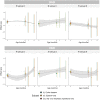Reproducibility of infant fNIRS studies: a meta-analytic approach
- PMID: 36908681
- PMCID: PMC9997722
- DOI: 10.1117/1.NPh.10.2.023518
Reproducibility of infant fNIRS studies: a meta-analytic approach
Erratum in
-
Erratum: Reproducibility of infant fNIRS studies: a meta-analytic approach (Erratum).Neurophotonics. 2023 Apr;10(2):029801. doi: 10.1117/1.NPh.10.2.029801. Epub 2023 Apr 4. Neurophotonics. 2023. PMID: 37034011 Free PMC article.
Abstract
Significance: Concerns about the reproducibility of experimental findings have recently emerged in many disciplines, from psychology to medicine and neuroscience. As NIRS is a relatively recent brain imaging technique, the question of reproducibility has not yet been systematically addressed.
Aim: The current study seeks to test the replicability of effects observed in NIRS experiments assessing young infants' rule-learning ability.
Approach: We conducted meta-analyses and mixed-effects modeling-based inferential statistics to determine whether effect sizes were replicable and comparable in a sample of 23 NIRS studies investigating infants' abilities to process repetition- and diversity-based regularities in linguistic and nonlinguistic auditory and visual sequences. Additionally, we tested whether effect sizes were modulated by different factors such as the age of participants or the laboratory. We obtained NIRS data from 12 published and 11 unpublished studies. The 23 studies involved a total of 487 infants, aged between 0 and 9 months, tested in four different countries (Canada, France, Italy, and USA).
Results: Our most important finding is that study and laboratory were never significant moderators of variation in effect sizes, indicating that results replicated reliably across the different studies and labs included in the sample. We observed small-to-moderate effect sizes, similar to effect sizes found with other neuroimaging and behavioral techniques in the developmental literature. In line with existing findings, effect sizes were modulated by the participants' age and differed across the different regularities tested, with repetition-based regularities giving rise to the strongest effects; in particular, the overall magnitude of this effect in the left temporal region was 0.27 when analyzing the entire dataset.
Conclusions: Meta-analysis is a useful tool for assessing replicability and cross-study variability. Here, we have shown that infant NIRS studies in the language domain replicate robustly across various NIRS machines, testing sites, and developmental populations.
Keywords: infant NIRS data; meta-analysis; replication crisis; rule learning.
© 2023 The Authors.
Figures








References
LinkOut - more resources
Full Text Sources
Research Materials

